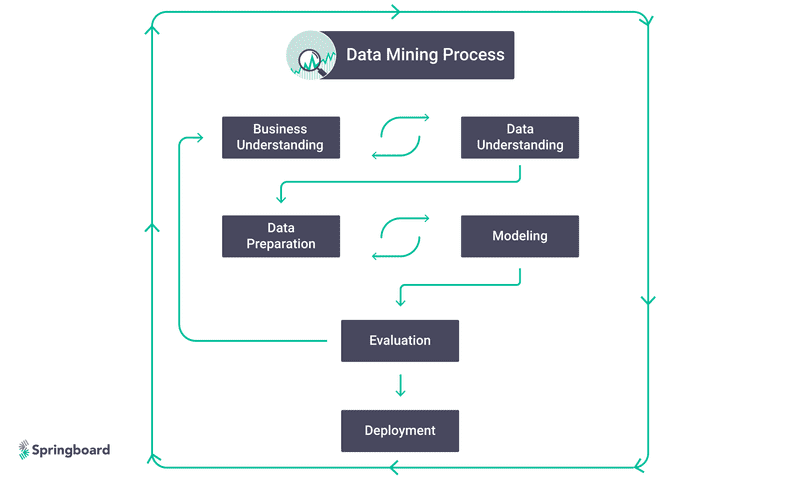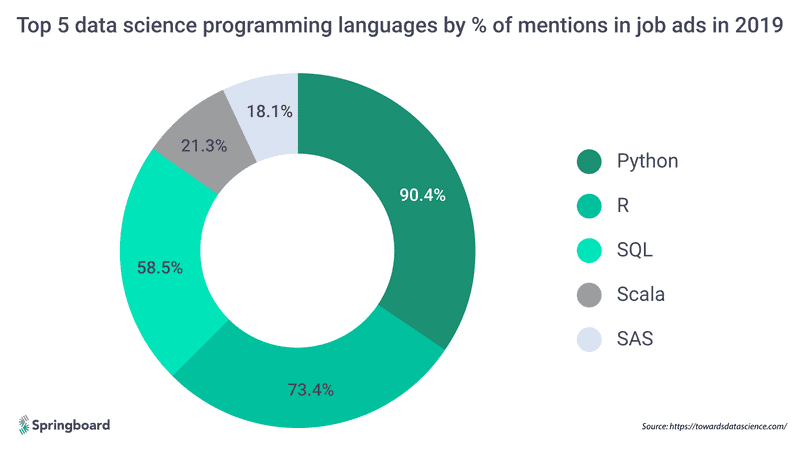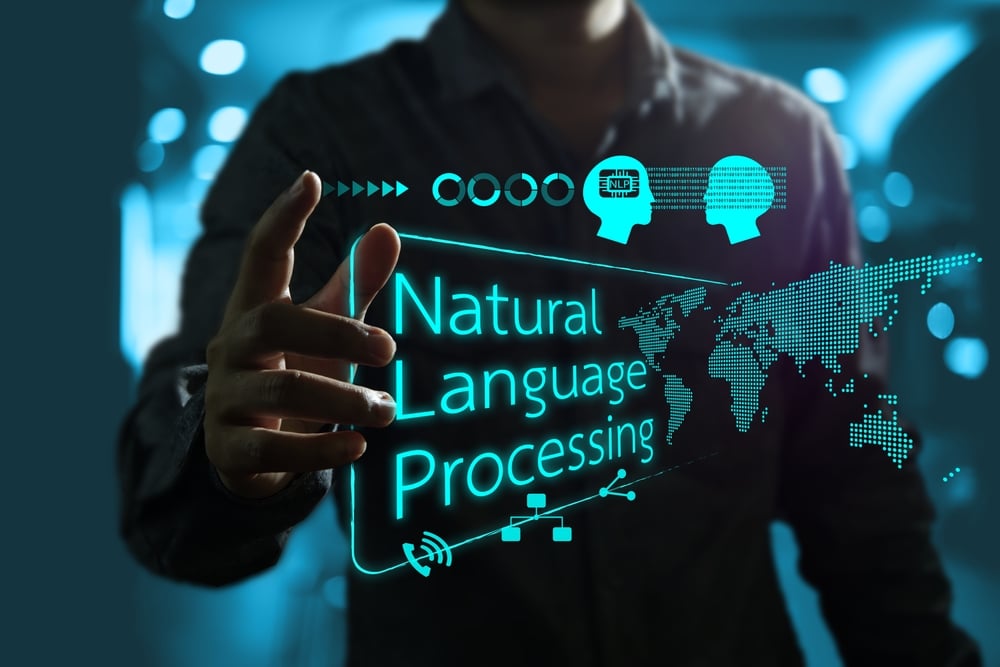Data mining is the process of finding anomalies, patterns, and correlations within large datasets to predict future outcomes. This is done by combining three intertwined disciplines: statistics, artificial intelligence, and machine learning.
Picking an online bootcamp is hard. Here are six key factors you should consider when making your decision.
Read on to learn more about the uses of data mining in the real world, important distinctions between data mining and other related data functions, and data mining tools and techniques.
What Is Data Mining?
Data mining is an automated process that consists of searching large datasets for patterns humans might not spot.
For example, weather forecasting is based on data mining methods. Weather forecasting analyzes troves of historical data to identify patterns and predict future weather conditions based on time of year, climate, and other variables.
This analysis results in algorithms or models that collect and analyze data to predict outcomes with increasing accuracy.
How Does Data Mining Work?
In the information economy, data is downloaded, stored, and analyzed for most every transaction we perform, from Google searches to online shopping. The benefits of data mining are applicable across industries, from supply chains to healthcare, advertising, and marketing.
Data mining business use cases typically center around personalizing customer experiences.
- For example, Spotify’s AI recommendation engine uses proprietary algorithms to understand a user’s music tastes and point the user towards new genres, artists, and tracks.
- In another example of data mining in business, insurance companies use data mining to evaluate the risk of a life insurance applicant and assign them a corresponding premium.
- Doctors also use data mining to check whether premature babies are developing dangerous infections.
Predictive analytics help businesses personalize user interactions, determine the best time to upsell or cross-sell a customer, identify cost inefficiencies in their supply chain, and analyze user behavior to deduce customer pain points.
Data Mining Process In 5 Steps
The data mining process consists of five steps. Learning more about each step of the process provides a clearer understanding of how data mining works.
- Collection. Data is collected, organized, and loaded into a data warehouse. The data is stored and managed either on in-house servers or in the cloud.
- Understanding. Business analysts and data scientists will examine the “gross” or “surface” properties of the data, and then conduct a more in-depth analysis from the perspective of a problem statement as defined by the business. This can be addressed using querying, reporting, and visualization.
- Preparation. Once available data sources are confirmed, they must be cleaned, constructed, and formatted into the desired form. This stage may also involve additional data exploration at a greater depth, informed by the insights uncovered in the previous stage.
- Modeling. In this stage, modeling techniques are selected for the prepared dataset. A data model is a diagram that describes the relationships between various types of information stored in a database. For example, a sales transaction is broken down into related groups of data points, describing the customer, the seller, the item sold, and the payment method. Each of these items must be described systematically to be stored and retrieved accurately from a database.
- Evaluation. Finally, the model results are evaluated in the context of business objectives. In this phase, new business requirements may be raised due to new patterns discovered in the model results, or other factors.

What Is Data Mining Often Confused With?
Data mining is often confused with a number of related terms. It’s important to understand how data mining differs from the terms it is often confused with.
- Data mining vs. data analysis. Data mining is a systematic process of identifying and discovering hidden patterns and information in a large dataset. Data analysis is a subset of data mining, which involves analyzing and visualizing data to derive conclusions about past events and use these insights to optimize future outcomes.
- Data mining vs. data science. Data mining falls under the field of study of data science, which also includes statistics, data visualization, predictive modeling, and big data analytics.
- Data mining vs. machine learning. Machine learning is the design, study, and development of algorithms that enable machines to learn without human intervention. Both data mining and machine learning fall under the field of data science, which is why the two terms are often confused. Machine learning can be used to automate data mining processes, and the data gathered from data mining can be used to teach machines.
- Data mining vs. data warehousing. Data warehousing is a process that is used to integrate data from multiple sources into a single database. Unlike data mining, data warehousing does not involve extracting insights from data; it merely concerns the infrastructure for storing, accessing, and maintaining databases.
3 Common Data Mining Applications
Data mining is used across a wide range of industries. Below are three common data mining applications in three fields: marketing, business analytics, and business intelligence.
- Marketing. Big data makes it possible to extract predictive insights about consumers from large databases, enabling businesses to learn more about their customers. For example, an e-commerce company could analyze customers’ past purchases, then use the analytics to target ads and make more relevant product recommendations. Data mining is also used for market segmentation. Cluster analysis enables the identification of a given user group according to common features within a database, such as age, location, education level, and so on. Segmenting the market enables the business to target specific groups for promotions, email marketing, and other marketing campaigns.Some businesses go so far as to use predictive analytics to infer implicit or future customer needs. For example, Target uses customer tracking technology to predict the likelihood that a woman is pregnant based on her purchases and sends specially designed ads in her second trimester.
- Business analytics. Business analytics is the process of transforming data into business insights. While business intelligence is descriptive (providing data-driven insights into current business performance), business analytics is more prescriptive. The focus of business analytics is on recognizing patterns, developing models to explain past events, create predictions for future events, and recommend actions to optimize business outcomes.
- Business intelligence. Business intelligence (BI) transforms data into actionable insights. While data science is mostly focused on analytics, which consists of analyzing trends and predicting the future, business intelligence gives a readout on the current state of the business by tracking key operations metrics in real-time. For example, a BI dashboard could show how many customers are buying a particular item during a promotion, or how many engagements a social media campaign is attracting.
Get To Know Other Data Science Students
Jonathan Orr
Data Scientist at Carlisle & Company
Rane Najera-Wynne
Data Steward/data Analyst at BRIDGE
Jasmine Kyung
Senior Operations Engineer at Raytheon Technologies
4 Key Data Mining Programming Languages
In order to become a data miner, there are four essential programming languages you need to learn: Python, R, SQL, and SAS.
- Python. As one of the most adaptable programming languages, Python can handle everything from data mining to website construction to running embedded systems, all in one unified language. Pandas is the Python data analysis library used for everything from importing data from Excel spreadsheets to plotting data with a histogram or box plot. The library is designed for easy data manipulation, reading, aggregation, and visualization. To learn more about data mining in Python, check out this comprehensive guide.
- R. R is an integrated suite of software facilities for data manipulation, calculation, and graphical display. As the de facto data science programming language, R can be used to solve any problem you encounter in data science. The software can implement machine learning algorithms quickly and simply and provides a variety of statistical and graphical techniques, such as linear and non-linear modeling, classical statistical tests, time-series analysis, classification, and clustering.
- SQL. SQL is a domain-specific programming language designed for managing and querying data held in a relational database management system (a type of database that stores and provides access to data points that are related to one another). You can use SQL to read and retrieve data from a database or update/insert new data. Creating a SQL query is often the very first step in any sequence of evaluation.
- SAS. SAS is a statistical software suite designed for data management, advanced analytics, multivariate analysis, business intelligence, a criminal investigation, and predictive analytics. It enables users to interact with their data using dynamic charts and graphs to understand key relationships.

7 Essential Data Mining Techniques
There are a number of data mining techniques. Below is a breakdown of the seven most essential techniques used by data scientists.
- Anomaly detection. Anomaly detection is the process of identifying instances that are anomalous or worrisome. Some anomalies can be detected by looking for deviations from averages. More sophisticated techniques involve looking for instances that don’t match any cluster or comparing data points with close examples to see if their feature values are vastly differentiated. For example, anomaly detection is used by credit card companies to alert customers to fraudulent transactions made using their credit cards by identifying transactions that don’t fit their typical buying patterns.
- Exploratory data analysis (EDA). Exploratory data analysis postpones any initial assumptions, hypotheses, or data models. Instead, data scientists seek to uncover the underlying structure of the data, extract important variables, and detect outliers and anomalies. Most of this work is done graphically because graphs are the easiest way to visually infer trends, anomalies, and correlations.
- Building predictive models. Predictive modeling is the process of using historical data to create, process, and validate a model or algorithm that can be used to forecast future outcomes. By analyzing past events, companies can use predictive modeling to forecast customer behavior as well as financial, economic, and market risks.
- Classification. Classification is the process of assigning items in a collection to target categories or classes. The goal is to accurately predict the target case for each case in the data. For example, classification helps to categorize loan applicants as low, medium, or high credit risk. This Springboard project—which uses R to analyze Yelp’s data to see if there were ways the rating system could be tweaked to make it easier to pick good Indian restaurants—is a great example of a data mining classification.
- Clustering. Clustering refers to finding items in a dataset with similar properties that can be categorized in the same class. While it might sound similar to classification, clustering is adaptable to changes and helps single out useful features that distinguish different groups. This is how millions of products on eBay are categorized every single day.
- Regression. Regression involves assigning a number to each item in a dataset. These numbers can be weighted (e.g., the probability of an event on a scale of one to 10), or related to time or quantity. The goal is to find an equation or curve that fits the data points, revealing how high the curve should be given any arbitrary input. Many regression techniques give each feature a weight and then combine the positive and negative attributes from the weighted features to generate an estimate.
- Decision trees. A decision tree is a non-parametric machine learning modeling technique for regression and classification problems. The model is hierarchical, meaning it consists of a series of questions that lead to a class label or value. For example, when a bank is considering whether to offer someone a loan, it goes through a sequential list of questions to assess the applicant’s credit risk, ending with a classification of either low, medium, or high risk.
Check out some more examples of applying data mining techniques here.
Essential Data Mining Tools
Data scientists use a range of statistical software applications like Spark and IBM SPSS Modeler to clean, organize, parse, analyze, and visualize data to convert it into usable information.
Thankfully, many data mining tools are open-source and free to use, so anyone can experiment with them.
Learn more about the best available free data mining tools here.
Data Mining: Frequently Asked Questions
Below you’ll find the answers to a number of frequently asked questions on data mining, how data mining is used in business, and more.
Who uses data mining?
Businesses across every industry and sector use data mining to extract business insights from their data, from retail to healthcare, manufacturing, banking, education and more. For example, companies with a low customer retention rate, such as utilities and telecommunications companies, use data mining to predict customer ‘churn’ based on customer behavior.
Data mining has non-commercial use cases, too. Local governments use it to predict graduation rates in their school districts, public health officials use it to predict the spread of infectious disease, and doctors use it to predict whether premature babies might develop dangerous infections.
How is data mining used in business?
In business, data mining is used to interpret and predict customer behavior using data analytics and track operational metrics in real-time using business intelligence.
Data mining helps businesses maximize revenue by discovering customer pain points, identifying opportunities for cross-selling and upselling, and minimizing risks when launching new products or business ventures.
What are the challenges of data mining?
The biggest impediment to effective data mining is poor data quality, such as incomplete data, missing or incorrect values, poor representation in data sampling, or noisy data (data with a large amount of meaningless additional information).
It can also be immensely difficult to integrate conflicting or redundant data from multiple sources and forms, such as combining structured and unstructured data. There is also the high cost of buying and maintaining software, servers, and storage applications to handle large amounts of data.
What makes data mining an important business tool?
Data mining helps businesses make more educated decisions based on real-world conditions. Data mining empowers businesses to develop smarter marketing campaigns, predict customer loyalty, identify cost inefficiencies, prevent customer churn, and personalize the customer experience using recommendation engines and market segmentation.
Does data mining require coding?
Yes. In addition to software, data scientists also use programming languages like R and Python to manipulate, analyze and visualize data.
What are the benefits of data mining?
Data mining empowers organizations to make better decisions based on real-time and historical data. By building models to predict future behaviors, businesses can have a better understanding of their customers, which gives them a competitive advantage.
Raw data in itself is not useful to businesses; it has to be processed and interpreted. Data mining is deployed in different ways across industries. For example:
- Financial institutions use data mining to evaluate a loan applicant’s credit risk and to protect their customers from fraud
- Insurance companies use data mining to decide how much to price their premiums
- Marketers use data mining to determine who will respond to a marketing campaign, and which channels will help them target their ideal customers
- Retailers also rely on data to manage inventory, decide on pricing strategies and even visual merchandising decisions such as knowing where to position certain products
Companies are no longer just collecting data. They’re seeking to use it to outpace competitors, especially with the rise of AI and advanced analytics techniques. Between organizations and these techniques are the data scientists – the experts who crunch numbers and translate them into actionable strategies. The future, it seems, belongs to those who can decipher the story hidden within the data, making the role of data scientists more important than ever.
In this article, we’ll look at 13 careers in data science, analyzing the roles and responsibilities and how to land that specific job in the best way. Whether you’re more drawn out to the creative side or interested in the strategy planning part of data architecture, there’s a niche for you.
Is Data Science A Good Career?
Yes. Besides being a field that comes with competitive salaries, the demand for data scientists continues to increase as they have an enormous impact on their organizations. It’s an interdisciplinary field that keeps the work varied and interesting.
10 Data Science Careers To Consider
Whether you want to change careers or land your first job in the field, here are 13 of the most lucrative data science careers to consider.
Data Scientist
Data scientists represent the foundation of the data science department. At the core of their role is the ability to analyze and interpret complex digital data, such as usage statistics, sales figures, logistics, or market research – all depending on the field they operate in.
They combine their computer science, statistics, and mathematics expertise to process and model data, then interpret the outcomes to create actionable plans for companies.
General Requirements
A data scientist’s career starts with a solid mathematical foundation, whether it’s interpreting the results of an A/B test or optimizing a marketing campaign. Data scientists should have programming expertise (primarily in Python and R) and strong data manipulation skills.
Although a university degree is not always required beyond their on-the-job experience, data scientists need a bunch of data science courses and certifications that demonstrate their expertise and willingness to learn.
Average Salary
The average salary of a data scientist in the US is $156,363 per year.
Data Analyst
A data analyst explores the nitty-gritty of data to uncover patterns, trends, and insights that are not always immediately apparent. They collect, process, and perform statistical analysis on large datasets and translate numbers and data to inform business decisions.
A typical day in their life can involve using tools like Excel or SQL and more advanced reporting tools like Power BI or Tableau to create dashboards and reports or visualize data for stakeholders. With that in mind, they have a unique skill set that allows them to act as a bridge between an organization’s technical and business sides.
General Requirements
To become a data analyst, you should have basic programming skills and proficiency in several data analysis tools. A lot of data analysts turn to specialized courses or data science bootcamps to acquire these skills.
For example, Coursera offers courses like Google’s Data Analytics Professional Certificate or IBM’s Data Analyst Professional Certificate, which are well-regarded in the industry. A bachelor’s degree in fields like computer science, statistics, or economics is standard, but many data analysts also come from diverse backgrounds like business, finance, or even social sciences.
Average Salary
The average base salary of a data analyst is $76,892 per year.
Business Analyst
Business analysts often have an essential role in an organization, driving change and improvement. That’s because their main role is to understand business challenges and needs and translate them into solutions through data analysis, process improvement, or resource allocation.
A typical day as a business analyst involves conducting market analysis, assessing business processes, or developing strategies to address areas of improvement. They use a variety of tools and methodologies, like SWOT analysis, to evaluate business models and their integration with technology.
General Requirements
Business analysts often have related degrees, such as BAs in Business Administration, Computer Science, or IT. Some roles might require or favor a master’s degree, especially in more complex industries or corporate environments.
Employers also value a business analyst’s knowledge of project management principles like Agile or Scrum and the ability to think critically and make well-informed decisions.
Average Salary
A business analyst can earn an average of $84,435 per year.
Database Administrator
The role of a database administrator is multifaceted. Their responsibilities include managing an organization’s database servers and application tools.
A DBA manages, backs up, and secures the data, making sure the database is available to all the necessary users and is performing correctly. They are also responsible for setting up user accounts and regulating access to the database. DBAs need to stay updated with the latest trends in database management and seek ways to improve database performance and capacity. As such, they collaborate closely with IT and database programmers.
General Requirements
Becoming a database administrator typically requires a solid educational foundation, such as a BA degree in data science-related fields. Nonetheless, it’s not all about the degree because real-world skills matter a lot. Aspiring database administrators should learn database languages, with SQL being the key player. They should also get their hands dirty with popular database systems like Oracle and Microsoft SQL Server.
Average Salary
Database administrators earn an average salary of $77,391 annually.
Data Engineer
Successful data engineers construct and maintain the infrastructure that allows the data to flow seamlessly. Besides understanding data ecosystems on the day-to-day, they build and oversee the pipelines that gather data from various sources so as to make data more accessible for those who need to analyze it (e.g., data analysts).
General Requirements
Data engineering is a role that demands not just technical expertise in tools like SQL, Python, and Hadoop but also a creative problem-solving approach to tackle the complex challenges of managing massive amounts of data efficiently.
Usually, employers look for credentials like university degrees or advanced data science courses and bootcamps.
Average Salary
Data engineers earn a whooping average salary of $125,180 per year.
Database Architect
A database architect’s main responsibility involves designing the entire blueprint of a data management system, much like an architect who sketches the plan for a building. They lay down the groundwork for an efficient and scalable data infrastructure.
Their day-to-day work is a fascinating mix of big-picture thinking and intricate detail management. They decide how to store, consume, integrate, and manage data by different business systems.
General Requirements
If you’re aiming to excel as a database architect but don’t necessarily want to pursue a degree, you could start honing your technical skills. Become proficient in database systems like MySQL or Oracle, and learn data modeling tools like ERwin. Don’t forget programming languages – SQL, Python, or Java.
If you want to take it one step further, pursue a credential like the Certified Data Management Professional (CDMP) or the Data Science Bootcamp by Springboard.
Average Salary
Data architecture is a very lucrative career. A database architect can earn an average of $165,383 per year.
Machine Learning Engineer
A machine learning engineer experiments with various machine learning models and algorithms, fine-tuning them for specific tasks like image recognition, natural language processing, or predictive analytics. Machine learning engineers also collaborate closely with data scientists and analysts to understand the requirements and limitations of data and translate these insights into solutions.
General Requirements
As a rule of thumb, machine learning engineers must be proficient in programming languages like Python or Java, and be familiar with machine learning frameworks like TensorFlow or PyTorch. To successfully pursue this career, you can either choose to undergo a degree or enroll in courses and follow a self-study approach.
Average Salary
Depending heavily on the company’s size, machine learning engineers can earn between $125K and $187K per year, one of the highest-paying AI careers.
Quantitative Analyst
Qualitative analysts are essential for financial institutions, where they apply mathematical and statistical methods to analyze financial markets and assess risks. They are the brains behind complex models that predict market trends, evaluate investment strategies, and assist in making informed financial decisions.
They often deal with derivatives pricing, algorithmic trading, and risk management strategies, requiring a deep understanding of both finance and mathematics.
General Requirements
This data science role demands strong analytical skills, proficiency in mathematics and statistics, and a good grasp of financial theory. It always helps if you come from a finance-related background.
Average Salary
A quantitative analyst earns an average of $173,307 per year.
Data Mining Specialist
A data mining specialist uses their statistics and machine learning expertise to reveal patterns and insights that can solve problems. They swift through huge amounts of data, applying algorithms and data mining techniques to identify correlations and anomalies. In addition to these, data mining specialists are also essential for organizations to predict future trends and behaviors.
General Requirements
If you want to land a career in data mining, you should possess a degree or have a solid background in computer science, statistics, or a related field.
Average Salary
Data mining specialists earn $109,023 per year.
Data Visualisation Engineer
Data visualisation engineers specialize in transforming data into visually appealing graphical representations, much like a data storyteller. A big part of their day involves working with data analysts and business teams to understand the data’s context.
General Requirements
Data visualization engineers need a strong foundation in data analysis and be proficient in programming languages often used in data visualization, such as JavaScript, Python, or R. A valuable addition to their already-existing experience is a bit of expertise in design principles to allow them to create visualizations.
Average Salary
The average annual pay of a data visualization engineer is $103,031.
Resources To Find Data Science Jobs
The key to finding a good data science job is knowing where to look without procrastinating. To make sure you leverage the right platforms, read on.
Job Boards
When hunting for data science jobs, both niche job boards and general ones can be treasure troves of opportunity.
Niche boards are created specifically for data science and related fields, offering listings that cut through the noise of broader job markets. Meanwhile, general job boards can have hidden gems and opportunities.
Online Communities
Spend time on platforms like Slack, Discord, GitHub, or IndieHackers, as they are a space to share knowledge, collaborate on projects, and find job openings posted by community members.
Network And LinkedIn
Don’t forget about socials like LinkedIn or Twitter. The LinkedIn Jobs section, in particular, is a useful resource, offering a wide range of opportunities and the ability to directly reach out to hiring managers or apply for positions. Just make sure not to apply through the “Easy Apply” options, as you’ll be competing with thousands of applicants who bring nothing unique to the table.
FAQs about Data Science Careers
We answer your most frequently asked questions.
Do I Need A Degree For Data Science?
A degree is not a set-in-stone requirement to become a data scientist. It’s true many data scientists hold a BA’s or MA’s degree, but these just provide foundational knowledge. It’s up to you to pursue further education through courses or bootcamps or work on projects that enhance your expertise. What matters most is your ability to demonstrate proficiency in data science concepts and tools.
Does Data Science Need Coding?
Yes. Coding is essential for data manipulation and analysis, especially knowledge of programming languages like Python and R.
Is Data Science A Lot Of Math?
It depends on the career you want to pursue. Data science involves quite a lot of math, particularly in areas like statistics, probability, and linear algebra.
What Skills Do You Need To Land an Entry-Level Data Science Position?
To land an entry-level job in data science, you should be proficient in several areas. As mentioned above, knowledge of programming languages is essential, and you should also have a good understanding of statistical analysis and machine learning. Soft skills are equally valuable, so make sure you’re acing problem-solving, critical thinking, and effective communication.
Since you’re here…Are you interested in this career track? Investigate with our free guide to what a data professional actually does. When you’re ready to build a CV that will make hiring managers melt, join our Data Science Bootcamp which will help you land a job or your tuition back!






